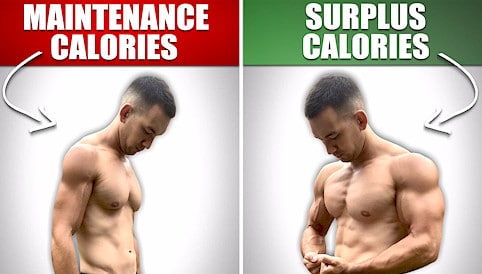“MAINGAINING” VS. BULKING: WHICH IS BEST FOR MUSCLE GROWTH?
Many people take “maingaining” too far. That causes them to slow down their muscle building results or even prevent them from making any gains at all.
In this article, we’ll cover what maingaining is, whether it can be beneficial, and if so, how you can implement it for optimal results.
What Is Maingaining?
The idea behind “maintaining” goes against the traditional bodybuilding wisdom where you alter between bulking and cutting.
Many people switch between bulking phases where they are in a calorie surplus and cutting phases where they are in a calorie deficit.
The bulking phase helps them gain weight and muscle while the cutting phase causes them to lose weight and fat.
Maingaining is different. You eat around your caloric maintenance level year-round and focus on slowly adding muscle without gaining fat.
There are different approaches to this. Some people say you should eat at exact caloric maintenance with no surplus at all. Others consider a small energy surplus of 100 or 200 calories still “maingaining.”
We’ll look at whether maingaining is beneficial, and if so, how you should set up your caloric intake. But first, let’s answer the question:
Do You Need A Calorie Surplus To Build Muscle?

A lot of people give a black and white answer to this question. They either state that you must be in a calorie surplus to grow or that it doesn’t matter.
The answer, however, is that it depends on factors such as:
- Your current body composition. As a beginner trainee, it’s much easier to gain muscle while eating at caloric maintenance (or being in a deficit) than if you’re already close to your genetic potential.
- What you mean by “building muscle?” Are we talking about building some muscle but not necessarily to your maximum potential? Or are we talking about 100% optimized muscle growth?
- Whether you are a natural or enhanced lifter. Drugs can alter the situation. In this article, we’ll focus on natural lifters.
- If you can take advantage of “muscle memory.” In case you lost muscle (e.g., due to an injury), it’s easier to regain that muscle, even at caloric maintenance, than if you would start from scratch.
- Whether you consume enough protein, train smart and hard enough, and get enough high-quality sleep. Such variables do impact your results.
- And more.
In other words, there is no set-in-stone answer. Various factors influence whether you can build muscle while eating at caloric maintenance. But in general, it is possible.
Why You CAN Lose Fat And Build Muscle At The Same Time

There are two main nutritional requirements to build muscle. First, you need protein to give your body the raw materials for making new muscle tissues. Second, you need calories to carry out that construction process.
Regarding calories, those can come from your diet, but that doesn’t have to be the case. Your body also stores calories in the form of body fat, which it can use whenever necessary.
As a result, your body can burn body fat and use the calories consumed through diet for muscle growth. That’s why you can build muscle and lose fat simultaneously, especially if you have a high body fat percentage.
The latter is because you’ll have plenty of stored energy. Then, as long as there’s a decent training stimulus and you get enough protein, your body can burn off the stored calories and use other resources for muscle growth.
So, if you’re overweight, you can gain muscle in a calorie deficit. In fact, this even works if you are skinny fat, meaning you have low amounts of muscle and a body fat percentage of around 15 to 20%.
That said, as you get leaner, your body becomes less willing to break down stored fat and use it for muscle growth. The reason is that you only have a finite amount of stored fat left. And that amount is important for health and survival.
Now, if you’re truly eating at maintenance, meaning your calorie intake matches your calorie expenditure exactly, the only place your body can get calories from for new muscle is fat tissue.
It can’t create energy out of thin air. And you can’t get endlessly leaner and leaner while gaining more and more muscle.
You can’t cut down to 10% body fat, “gaintain” for the next five years, and continue to lose fat while gaining muscle. It doesn’t work like that.
You’ll hit a point where your body says, “okay, there’s this stressor that is a potential threat (your workouts), but I can’t sacrifice more body fat because I don’t have enough left.
“Even if I do add more muscle, it’ll cost more calories to maintain it. Therefore, we have to make a tradeoff and leave things as they are.”
Remember: the body is ultimately a survival and replication machine. It doesn’t care that you want to look like your favorite Instagram fitness influencer.
Your body is just trying to survive based on the external stressors, the calories and nutrients coming in, and how much fat there is stored.
That’s why it’s not true that you can eat at exact maintenance and continue to gain more and more muscle over time once you’re already lean.
Performance-enhancing drugs can alter this somewhat, especially if you have good genetics to begin with. But it won’t happen for natural trainees, especially those with average genetics.
And this is the problem I often see. People want to build muscle but are terrified of gaining some fat.
As a result, they keep their calorie intake too low, causing them to spin their wheels without gaining a meaningful amount of muscle.
I know some people are going to disagree with this. They’ll say, “nope, not true, I’ve always eaten at maintenance and gained muscle so you don’t know what you’re talking about.”
Well, the reality is that no one knows what their exact caloric maintenance level is in the first place. That’s impossible to track. There are too many factors that influence it, and it fluctuates from day to day.
Also, no one knows the exact number of calories they consume. Even if you weigh all your foods to the precise gram, there would still be variation.
Besides, when you train hard, your appetite will increase. This often causes people to consume a bit more food throughout the day to compensate for that hunger.
When they then control their diet and eat to satiation but not indulge any further, they think they’re eating at maintenance.
In reality, they’re likely in a small calorie surplus without realizing it, even if it’s just a hundred extra calories per day. Their body is calibrating its hunger cues to encourage them to eat more.
Your body wants that extra energy so that it can build muscle without needing to sacrifice body fat.
How to Find Out If You Are Indeed In A Small Calorie Surplus

If someone is gaining weight consistently, they are, by definition, in a calorie surplus.
If someone starts at 150 pounds and after a couple of months weighs 165, they couldn’t have done that by “maingaining.” They must have been in a positive energy balance.
Sure, someone’s body weight can change over the course of a day or days for various reasons. Examples are changes in water retention, glycogen storage, and stool build-up in the colon.
That’s why short-term body weight changes often aren’t an accurate indicator of whether someone is in a calorie surplus. But if they gain weight over weeks and months, they surely are.
Thus, if someone tells you to only eat at maintenance, in effect they say you won’t gain any bodyweight moving forward.
If you weigh 150 pounds right now, that’s it. You won’t get any heavier. You’ll have to somehow achieve a more muscular body by swapping body fat for muscle.
That’s why the idea of maingaining by eating at maintenance is not effective long-term if you’re already lean.
Here’s What To Do
At some point, it doesn’t make sense anymore to eat at caloric maintenance. To gain more muscle, you’ll have to give your body an alternate energy source in the form of more dietary calories.
What does this mean for you in practical terms? It means that if you carry excess amounts of fat, you can be in a calorie deficit, lean down, and gain muscle as long as your training is on point.
But once you’re somewhat lean (e.g., <12% body fat ), you must be in a calorie surplus to further stimulate gains. Otherwise, your muscles won’t grow.
This doesn’t mean you need a massive calorie surplus. And it doesn’t mean you need to get fat during the process. Not at all. Dirty bulking is a waste of time and effort.
Your body can only use a limited amount of calories per day for building new muscle. Anything beyond that will just be stored as fat. That’s why you don’t need a huge surplus.
We’re talking about around 100 to 300 calories above maintenance. That’ll be enough to optimize muscle growth without gaining excess fat.
Also, you don’t have to maintain such a calorie surplus for a year or longer. If you’re worried about gaining fat, it’s fine to do a short bulk and then take some time to lean down.
For example, you could do a three or six months bulk where you maintain a small calorie surplus and then take eight to twelve weeks to get rid of some excess fat you might have gained.
In fact, if leanness is a priority for you, you could even further shorten those cycles. You could maintain a small surplus for several weeks instead of several months.
Just keep an eye on your body fat percentage. Once you’ve gotten softer than you’d like, drop into a quick deficit, strip off the extra fat, and then rinse and repeat.
There’s nothing wrong with such an approach as long as you execute it properly and give yourself those periods with a definite surplus.
If your training is solid and you’re eating enough protein, you should be able to consistently gain muscle while staying relatively lean long term. You’ll just have a slight ebb and flow in your body fat level.
So, you’re not going to bulk all the way up and then cut all the way back down. You’re going to stay in this middle zone.
You give your body the extra calories it needs to optimize growth, fuel training sessions, and enhance recovery.
The Bottom Line On Maingaining Vs. Bulking

If you’re already relatively lean, you will not gain a significant amount of muscle long term by eating at your exact maintenance level.
You can gain muscle during the initial stages of your fitness journey by doing that, especially if you carry excess fat, but it is not a viable approach in the long run. You’ll need a calorie surplus to continue making gains.
I guarantee that the jacked dudes you see on YouTube and Instagram – natty or not – did not get there by “gaintaining” right out of the gate.
They might be gaintaining now. But they didn’t build most of their muscle mass that way.
So, maintain a small surplus until your body fat level climbs outside your comfort zone. Then, implement a quick deficit, strip off the fat, and rinse and repeat. That’ll allow you to build muscle while staying lean.
If you found this article helpful, make sure to sign up for your FREE custom fitness plan below...





